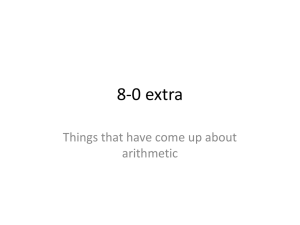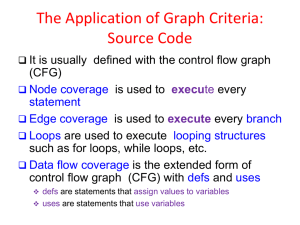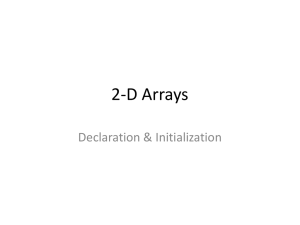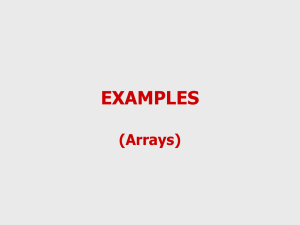Lecture Method Revision
advertisement
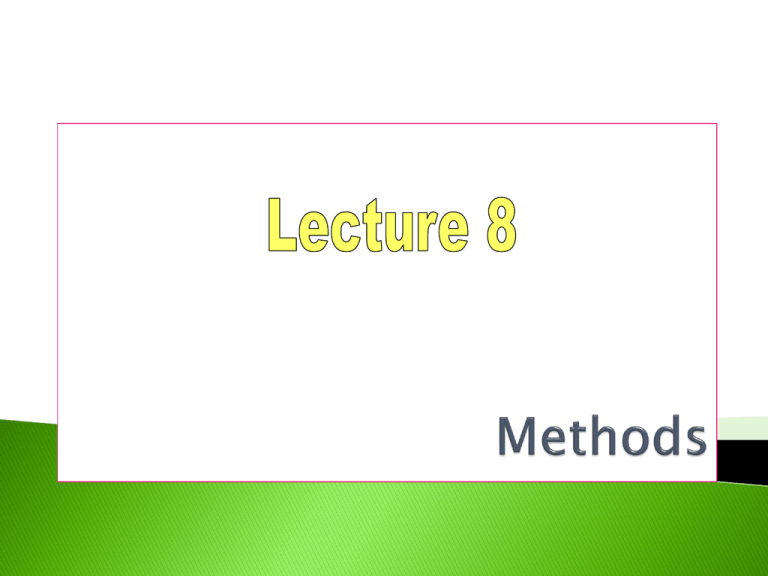
Draft timetable has the same times as this
semester: ◦ Monday 9:00 am to 12:00 noon, 1:00 pm to 3:00 pm.
◦ Tuesday 9:00 am to 12:00 noon, 1:00 pm to 3:00 pm.
◦ Thursday 9:00 am to 12:00 noon, 1:00 pm to 3:00 pm.
Not necessarily lectures in the afternoons.
◦ Some modules have lectures during the morning and
workshops/tutorials in the afternoons.
Module classes are mostly on the same day (but
not always).
It depends on which modules that you are taking.
To be able write larger programs
◦ By breaking them down into smaller parts and
passing data between the parts.
To understand the concepts of Methods
◦ To be able to write programs that use Methods
from Library classes.
◦ To be able to write Methods for use in your
programs.
◦ To develop an active understanding of the different
kinds of method and their uses
We have looked at developing algorithms for
solving problems.
We saw how the problem could be broken
down into separate stages, then each stage was
further broken down into more detailed steps.
◦ We repeat this process until we have single
instructions.
This is Stepwise Refinement.
We can regard the first level stages as separate
(smaller) programs.
◦ Similarly, we can regard any group of (related) single
instructions as a small program.
We are programming a robot to make a cup of
tea using tea leaves and a tea pot. This can
take several steps: 1. Put leaves in the pot
2. Boil some water
3. Add water to the pot
4. Wait 5 minutes
5. Pour tea into cup
5
1. Put leaves in the pot
1.1. Open tea caddy
1.2. Scoop out a spoonful of tea
1.3. Tip the spoon into the pot
1.4. Close tea caddy
2. Boil some water
2.1. Fill kettle with water
2.2. Switch on the kettle
Many of the
steps can be
broken down
into smaller
steps.
2.3. Wait until water is boiled
2.4. Switch off kettle
3. Add water to the pot
6
1. Put leaves in the pot
1.1. Open tea caddy
1.1.1. Take caddy from cupboard
1.1.2. Remove lid from caddy
1.2. Scoop out a spoonful of tea
1.3. Tip the spoon into the pot
1.4. Close tea caddy
1.4.1. Put lid on caddy
1.4.2. Return caddy to cupboard
2. Boil some water
2.1. Fill kettle with water
2.1. Take kettle to the water tap
7
The small programs (or SubPrograms)
described are known as Methods.
The main program making tea then becomes
a series of smaller SubPrograms or Methods.
Making Tea
1. Put leaves in pot
2. Boil some water
3. Add water to pot
4. Wait
5. Pour tea into cup
Methods
In the tea-making example, each method
would most likely just involve a fixedmovement by the robot. Even if sensors were
required, this could all be dealt with inside the
method.
Methods of this kind, which
◦ do not need any data, and
◦ do not give us any results
are just one of four main types…
1.
2.
3.
4.
Four Types of Method exist:
Those which ‘do something’ but don’t require any
data from the main program and which don’t
return any data to the main program (no data in
or out).
Those which ‘do something’ where the
‘something’ depends on data supplied by the
main program but don’t return any data to the
main program (data in).
Those which ‘do something’ and then do return
resulting data to the main program (data out).
A combination of the last 2 – Require data from
the main program and return data back to the
main program (data in and out).
No data in, no data out
Data in, no data out
◦ e.g. the methods for the tea-making robot
◦ e.g. telling the robot to move a certain distance:
robot.moveForward(50)
No data in, data out
◦ e.g. getting information from the computer’s operating system:
int t = currentTimeMillis() // t would contain the current time in
milliseconds after this code is run
Data in, data out
◦ e.g. a method to square a given number:
int result = square(3); // result would contain 9 after this code
is run
You may not have realised it at the time but
you have already used some methods…
◦ main () belongs to the class in which it is declared.
◦ println () belongs to the System.out class
◦ showInputDialog () belongs to the JOptionPane
class
◦ parseDouble () belongs to the Double class
The data passed into a method when it is
called are known as parameters
If the method gives us some data back, this is
known as the return value
A Method may require more than one Input
parameter
◦ or none at all
A Method can only return a single Output
return value
◦ or none at all
Some Methods may have Optional input
parameters
◦ these will take Default values if not supplied
Looking at our example methods…
◦ main() has a single (optional) input parameter…
an array of Strings (supplied when calling the program)
we will look at arrays later on.
◦ println() has a single (optional) input
parameter…
a String which will be printed out on the console
e.g. System.out.println("Hello World");
Input Parameter
showInputDialog() requires a single Input
parameter and returns a single parameter…
◦ both parameters are Strings
◦ e.g.
sWidth = JOptionPane.showInputDialog(null,"Enter width.");
Output Variable
Input Parameter
◦ This will show the Input Dialog with the message from the
Input parameter…
◦ When the user clicks the OK button the text they typed will
be returned and stored in the String variable sWidth.
parseDouble() requires a single Input
parameter and returns a single value…
◦ the input parameter is a String
◦ the output is a double (a number)
◦ e.g.
dWidth = Double.parseDouble(sWidth);
Output Variable
Input Parameter
◦ This will convert the text in the String sWidth into a number
◦ and return this number which will be stored in the double
variable dWidth
Consider the following code:
public class MethodDemo {
public static void main (String args[]) {
sayHello();
int result = square(2);
System.out.println(result);
}
‘main’ method:
the entry point of
our code
public static void sayHello() {
System.out.println("Hello! ");
}
public static int square(int x) {
return x * x;
}
}
methods that the
‘main’ method
will call
The sayHello() method in more detail:
nothing is
returned
name of
method
empty
parameter
list ‘()’
public static void sayHello() {
System.out.println("Hello! ");
}
our method does not
require any
parameters
The square() method in more detail:
an integer
is
returned...
name of
method
public static int square(int x) {
return x * x;
}
… and the value of that integer is
given by this expression
this
method
requires
an integer
In our main method, we have the following
code:
public static void main(String args[]) {
sayHello();
int result = square(2);
System.out.println(result);
}
◦ The program will:
output the word Hello
calculate the result of 2 * 2
output the result
Parameters
Used for passing
data to a method
int calculateArea(int w, int h) {
int area = w * h;
return area;
Return type
Defines the type
of data to be
passed from the
method.
Keyword void is
used here if
method returns
no data.
}
Return statement
Used for passing
data from the
method.
Omitted for void
methods.
Parameters values
Are used to transfer
data to a method.
int calculateArea(int w, int h) {
int area = w * h;
return area;
}
int area;
area = calculateArea(2, 5);
System.out.println( "Area = " + area);
Return value
Contains the data
passed from the
method.
Here it is copied
into a variable.
A call to a method
called calculateArea
A non-void method can be called
anywhere an expression of the
same type is permitted.
e.g. from within calculations.
Consider these two methods:
public void square1 (int y)
{
System.out.println(y * y);
}
public int square2 (int y)
{
return (y * y);
}
Both calculate the square of the number that is
supplied by the input parameter.
The first simply prints out the computed value.
◦ i.e. the value is lost
The second returns the computed value
◦ i.e. the value can be used by the program that called
the method
Variables passed TO a method as Parameters
are passed by VALUE only.
The name they are given in the method
parameters is unique to the method
◦ even if it is the same as a variable in the main
program
Changes to the value of such a variable in the
method are NOT ‘seen’ by the main program.
◦ consider the program and method on the next
slide…
…
int y, result;
y = 3;
result = square(y);
…
When square() is called, the
parameter x takes on the value of
variable y in the main program
public static int square(int x)
{
x = x * x;
return x;
Inside the
}
computer’s memory
however, x and y are totally
separate
Method to square a number:
public static int square(int x) {
x = x * x;
return x;
}
Main method…
What would be the output?
…
int x, y;
x = 2;
y = square(x);
System.out.println(x + " squared = " + y);
…
2 squared = 4
In addition to variables passed in as
parameters a method may also declare Local
Variables
◦ These only exist in the method.
◦ They cease to exist when the method terminates.
◦ The ‘main’ program cannot ‘see’ them.
Example…
int highest(int x, int y)
{
int temp;
if( x > y) {
temp = x;
} else {
temp = y;
}
return temp;
}
Local variable
Read Chapter 8 of Currie
Workshop 8 on Wolf

